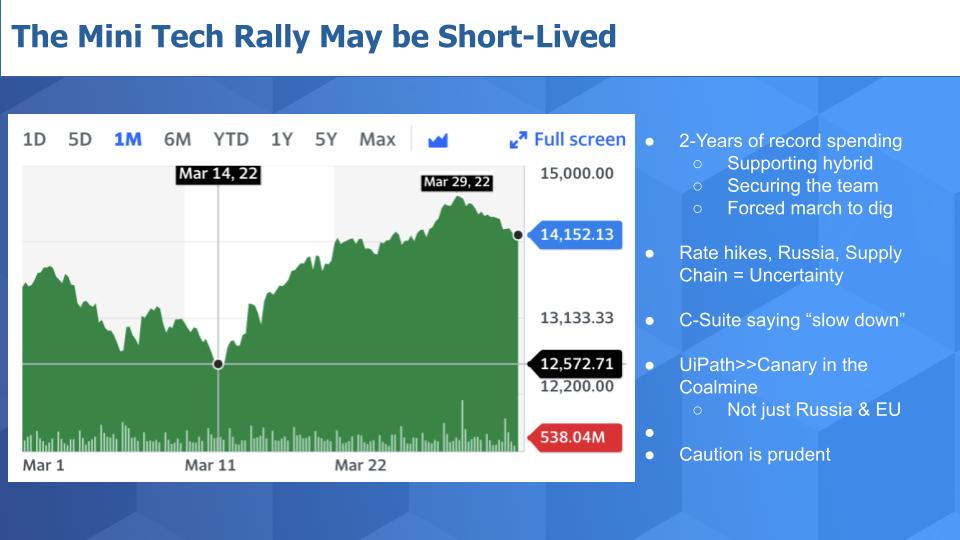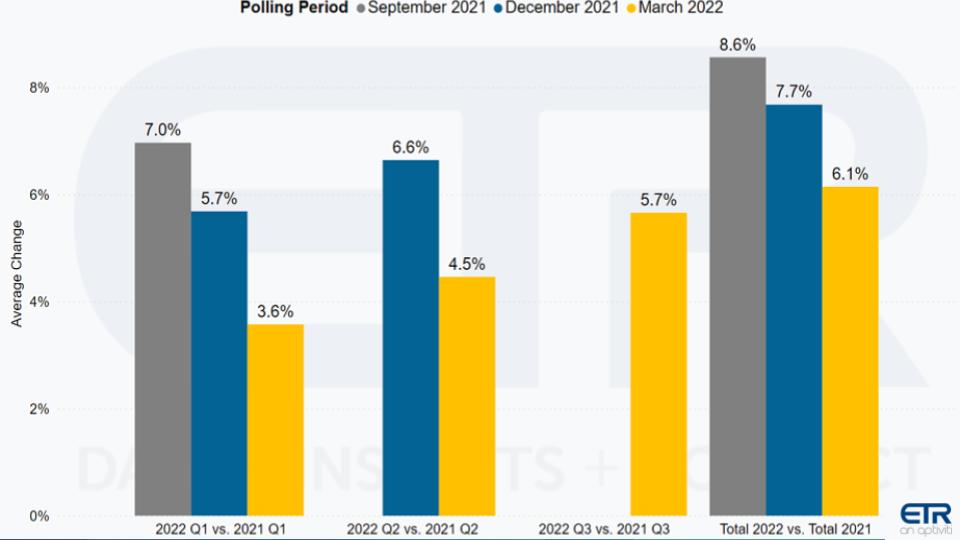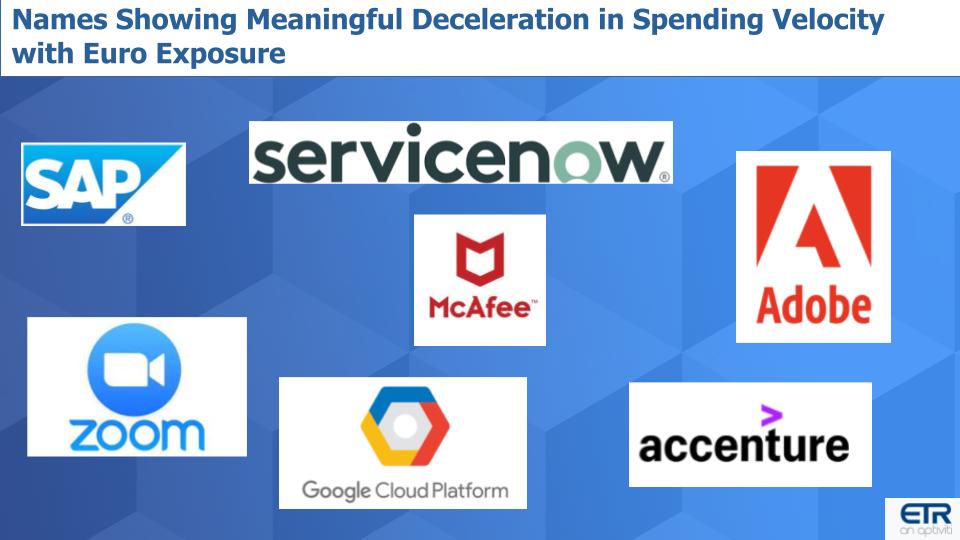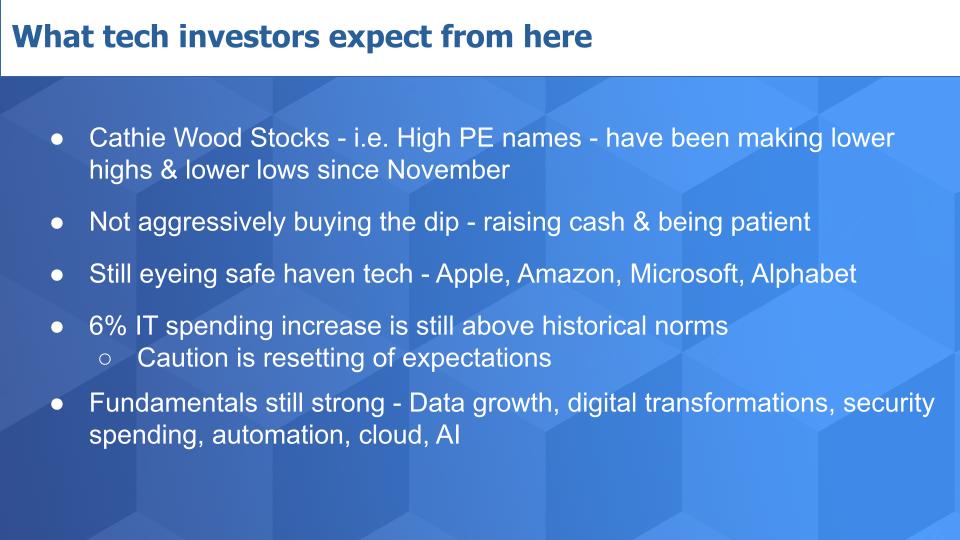 CLOUD
CLOUD
 CLOUD
CLOUD
 CLOUD
CLOUD
The tech spending party’s over — at least for now.
Fresh survey data from Enterprise Technology Research shows a clear deceleration in spending and a more cautious posture from technology buyers. Just this week we saw sell side downgrades in hardware companies such as Dell Technologies Inc. and HP Inc., and revised guidance from highflier UiPath Inc., citing exposure to Russia, Europe and certain sales execution challenges.
But these headlines are a canary in the coal mine, pointing to broader tech spending softness. According to ETR analysis and channel checks in theCUBE community, the real story is that these issues are not isolated. Rather, we’re seeing signs of caution from buyers across the board in enterprise tech.
In this Breaking Analysis, we are the bearers of bad news, relatively speaking. We’ll share a first look at new data that suggest a tightening in tech spending, calling for 6% growth this year, which is below our January prediction of 8% for 2022.

It’s really not surprising, right? We’ve had a two-year record run in tech spending and big rises in high-flying technology stocks. Hybrid work, equipping and securing remote workers, the forced march to digital… these were all significant tailwinds for tech companies.
The Nasdaq peaked late last year and then, as you can see in the chart above, bottomed in mid-March. Then it made a nice run up through the 29th of last month. But the mini-rally appears to be in jeopardy. With Fed rate hikes, Russia and supply chain challenges, there’s lots of uncertainty. So we should expect the C-suite to be saying, “Slow down.”
We don’t think the concerns are confined to companies with exposure to Russia and Europe. We think it’s more broad-based and caution from technology companies and tech buyers is prudent.
Unfortunately, it looks like the two-year party has ended and, as our ETR colleague Erik Bradley said, “a little hangover shouldn’t be a surprise to anyone.”

We’re limited in what we can share with you today because ETR is in its quiet period and hasn’t released full results yet outside its private client base. But it did put out an alert today and we can share the slide above. It shows the expectation on spending growth from more than a thousand chief information officer and information technology buyer respondents.
The key focus areas in this data are the yellow bars, which depict the most recent survey data as compared with the blue and gray bars – which are the December and September 2021 results, respectively. You can see a steep drop from last year in Q1, lowered expectations for Q2 and, at the far right, a drop from nearly 9% last September and around 8% in December to just over 6% today.
Now you may think a 200-basis point downgrade from our prediction in January of 8% seems somewhat benign. But in a $4 trillion market, that’s $80 billion coming off the income statements of tech companies.
The good news is that 6% growth is still very strong and higher than pre-pandemic spending levels.
The buyers we’ve talked to this week are saying: “Look, we’re still spending… we just have to be more circumspect about where and how fast.”
There were a few other call-outs in the ETR data, in our discussions with Erik Bradley and in the outreach to theCUBE community.

First, it looks as if buyers, in response to expected supply constraints, pulled forward their orders late last year and earlier this year. Remember when we couldn’t buy toilet tissue? People started to stockpile and that created a “rubber banding effect.” So we saw similar stockpiling and are now watching momentum recede in the personal computer and laptop market.
But as we said, this is not isolated to PCs. UiPath’s earnings guidance confirmed this, but the story doesn’t end there. This is not isolated to UiPath, in our view. Rather, it’s a more broad-based slowdown.
The other big sign is spending in outsourced IT, which is showing a meaningful deceleration in the latest survey. Net Score in this sector dropped from 13% in January to 6% today. Net Score is a measure of the net percentage of customers in the survey that, on balance, are spending more than they were last survey. It’s essentially derived by subtracting the percentage of customers spending less from those spending more.
That represents a 700-basis point drop in three months — in a market where you can’t hire enough people. The percentage of companies hiring has gone from 10% during the pandemic to 50% today, according to ETR data. And we know there’s still an acute skills shortage. So you would expect more IT outsourcing, but it’s down.
This statement from ETR’s Erik Bradley explains further:
Historically, when outsourced IT drops like this, especially in a tight jobs market, it’s not good news for tech spending.

The other interesting call-out from ETR were specific company names that appear to be seeing the biggest change in spending momentum. There’s a focus on Europe, but it’s more broad-based, we believe.
The above graphic lists the biggest changes at the margin.
SAP SE has big exposure to on-premises installations. ServiceNow Inc. has European exposure and also broad-based exposure in IT. Zoom Video Communications Inc. didn’t go to the moon — no surprise given the quasi-return to work and Zoom fatigue.
McAfee Corp. is a concern because security seems to be the one area that is somewhat insulated from the spending caution. Okta Inc. had the hack and we’re going to cover that next week with some new data from ETR but generally security has been holding up well – CrowdStrike Holdings Inc. and Zscaler Inc. in particular.
Adobe Inc. is another company that had a nice bounce in the last couple of weeks. Accenture plc speaks to the outsourcing headwinds we mentioned earlier.
The callout for Google Cloud Platform is a bit of a concern. It’s a name that is still elevated in overall, but down from its previous levels. And well down in Europe – under that magic 40% Net Score mark that we sometimes like to cite as the elevated Net Score level.

The ARKK investment stocks of Cathie Wood fame have been tracking on a downward trend since last November, meaning they’re making lower highs and lower lows since then. The trend is not their friend.
Investors we speak with are being much more cautious about buying the dip in tech. They’re raising cash on the upswings and being more patient. Traders can buy in this environment and hedge their bets with short plays. But unless you can pay attention by the minute and you know what you’re doing, you’re going to get whipsawed. That may happen even if you’re a pro.
Investors tell us they’re still eyeing big tech. Even though Apple Inc. has been on a recent tear and has some exposure. They’ll look for entry points in the chop for Apple, Amazon.com Inc., Microsoft Corp. and Alphabet Inc.
And to stress again, 6% spending growth is still very solid. We’re simply resetting the outlook relative to previous expectations due to some unforeseen factors such as Ukraine.
When you zoom out and look at the growth in data, getting digital right, security investments, automation, cloud, AI, containers and new areas of growth such as telco and 5G, the fundamentals have not changed. These technologies are all powering the new digital economy and we believe these developments represent a prudent pause versus a shift in the importance of tech.
One point of caution is that there’s a lot of discussion around a shift in global economies, supply chain uncertainty, persistent semiconductor shortages – especially in areas such as driver chips and parts for displays, analog components, microcontrollers, power regulators and the like. it’s a bunch of boring but important stuff that is not playing nice these days. And this creates uncertainty, which sometimes picks up momentum.
Don’t be surprised to see savvy chief financial officers project tepid guidance on upcoming earnings calls.
Managements will often take advantage of broad-based negative sentiment to let a little air out of expectations and ride the choppiness with the herd. There’s really not a ton of upside for companies to fight fashion in this market until sentiment and technicals change course.
We’re watching these trends closely and we’ll be vigilant – reporting to you when we see changes in the data, and in our forecasts.
Thanks to Stephanie Chan, who researched several topics for this episode, and to Alex Myerson on production. Alex handles the podcasts and media workflows. And special thanks to Kristen Martin and Cheryl Knight, who help us keep our community informed and get the word out.
Remember we publish each week on Wikibon and SiliconANGLE. These episodes are all available as podcasts wherever you listen.
Email david.vellante@siliconangle.com, DM @dvellante on Twitter and comment on our LinkedIn posts.
Also, check out this ETR Tutorial we created, which explains the spending methodology in more detail. Note: ETR is a separate company from Wikibon and SiliconANGLE. If you would like to cite or republish any of the company’s data, or inquire about its services, please contact ETR at legal@etr.ai.
Here’s the full video analysis:
All statements made regarding companies or securities are strictly beliefs, points of view and opinions held by SiliconANGLE media, Enterprise Technology Research, other guests on theCUBE and guest writers. Such statements are not recommendations by these individuals to buy, sell or hold any security. The content presented does not constitute investment advice and should not be used as the basis for any investment decision. You and only you are responsible for your investment decisions.
Support our mission to keep content open and free by engaging with theCUBE community. Join theCUBE’s Alumni Trust Network, where technology leaders connect, share intelligence and create opportunities.
Founded by tech visionaries John Furrier and Dave Vellante, SiliconANGLE Media has built a dynamic ecosystem of industry-leading digital media brands that reach 15+ million elite tech professionals. Our new proprietary theCUBE AI Video Cloud is breaking ground in audience interaction, leveraging theCUBEai.com neural network to help technology companies make data-driven decisions and stay at the forefront of industry conversations.